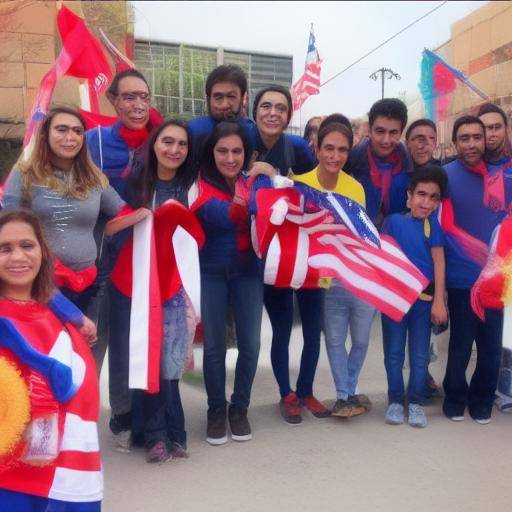
Thanksgiving, one of the most emblematic holidays in North America, is marked by family union, gratitude and a gastronomic feast that includes the famous turkey, the memory of the pilgrims and the spectacular Macy's parade. In this article, we will explore in detail these key elements of this celebration, its historical relevance, its impact on contemporary society and the traditions surrounding them.
History and Origins of Thanksgiving
Thanksgiving has its roots in celebrating the first harvest of pilgrims who arrived in America in 1621. These settlers celebrated a feast with the Native Americans to show their gratitude for the abundance of food. From this moment on, it was established as a tradition to give thanks for the blessings received throughout the year.
Over the centuries, the celebration has evolved, integrating rituals, customs and the inclusion of turkey as a main dish in the feast. The turkey figure has become an iconic symbol of this date, being an essential element in the tables of millions of households in North America.
El Pavo: Festín star
The roast turkey is a central element at the Thanksgiving table. Sharing this dish with family and friends is an entrenched tradition that symbolizes abundance and communion. The preparation of turkey is a whole ritual, involving culinary techniques, family recipes and secrets passed from generation to generation.
The aromatic taste of roast turkey, combined with garrisons such as mashed potatoes, cranberry sauce and filling, creates a culinary experience that enhances the meaning of gratitude and family union in this holiday.
Pilgrims: The Historical Footprint
The pilgrims who arrived in America in the seventeenth century play a fundamental role in celebrating Thanksgiving. Their tenacity, resilience and community spirit have left an indelible mark in the history of this festival. Remind your legacy during this date strengthens the sense of gratitude and unity among current generations.
The figure of the pilgrims reminds us of the importance of solidarity, adaptation to new circumstances and the celebration of diversity, values that transcend time and remain in force in the commemoration of Thanksgiving.
The Macy's Parade: Tradition and Fantasy Show
The Macy's parade, a renowned event held in New York City, is a manifestation of creativity, colour and entertainment that marks the beginning of the Christmas holidays. With giant balloons, stunning floats and live performances, this parade is a show that attracts thousands of viewers and viewers from around the world.
Since its inception in 1924, the Macy's parade has become an entrenched tradition that symbolizes the joy, imagination and magic of the Christmas season. His iconic inflatable figures, such as the famous Snoopy or Sponge Bob, attract both children and adults, becoming an unforgettable experience for those who witness it.
Conclusion
In short, Thanksgiving is a celebration that unites tradition, gratitude and celebration in North America. From the turkey as the main dish at the table, to the reverence of the founding pilgrims and the magnificent Macy's parade, each component of this celebration brings meaning and enriches the collective experience. Regardless of the ways it takes place, Thanksgiving invites us to reflect on our blessings, strengthen our family and community ties, and share the joy of being grateful. This festival remains a reminder of the fundamental values that transcend generations and borders.
Frequently asked questions
What is the importance of turkey on Thanksgiving?
The turkey is the central dish at the celebration of Thanksgiving and symbolizes wealth and family unity. The preparation of the turkey is a culinary ritual that unites families and promotes gratitude for food and coexistence.
Why do pilgrims remember themselves at this holiday?
The pilgrims represent the historical legacy of the festival, as they were the first settlers to celebrate the first harvest with the Native Americans. Its spirit of community, tenacity and adaptation is a source of inspiration for the sense of gratitude and union on Thanksgiving.
What is the origin of the Macy's parade?
The Macy's parade originated in 1924 in New York City as a way to celebrate the start of the Christmas season. Since then, it has become an annual tradition that contains a display of colour, creativity and entertainment, marking the enthusiasm and joy of the coming holidays.
How has the celebration of Thanksgiving evolved over the years?
Over the years, the celebration of Thanksgiving has evolved in terms of associated menus, rituals and customs. If initially a harvest-centred holiday, it has become a family and community celebration with a broader meaning that involves gratitude and unity.
What is the cultural relevance of Thanksgiving today?
Thanksgiving continues to be a deeply rooted holiday in American and Canadian culture, serving as an annual reminder of the importance of worrying about others and thanking shared blessings. The festival reaffirms cultural identity and promotes reflection on family and community values.
How is Thanksgiving celebrated in different regions of North America?
Thanksgiving celebrations can vary in different regions of North America, with differences in traditional dishes, activities and local customs. However, the essence of gratitude, family union and the celebration of shared blessings remains the core of the festival everywhere.
In conclusion, Thanksgiving is a celebration that unites history, tradition and joy on an occasion that fosters gratitude and unity. From the symbolism of the turkey to the legacy of the pilgrims and the splendor of the Macy's parade, each aspect of this festival adds meaning and enriches the collective experience, making each celebration unique and memorable.
